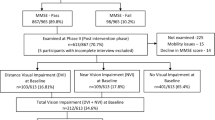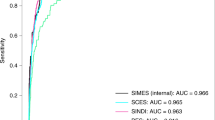Abstract
Purpose
To describe the prevalence of visually significant cataract in Indigenous and non-Indigenous Australians.
Methods
A total of 3098 non-Indigenous Australians aged 50 years and over and 1738 Indigenous Australians aged 40 years and over, residing in 30 randomly selected Australian sites, were examined as part of the population-based National Eye Health Survey (NEHS). For those with visual acuity worse than 6/12, photos of the anterior and posterior segment were taken with a nonmydriatic fundus camera and assessed for cataract. Visually significant cataract was assigned in eyes with best-corrected visual acuity worse than 6/12 and cataract that was determined to be the primary cause of vision loss in that eye.
Results
In total, 99.2% (4797/4836) participants had complete data for visual acuity and cataract assessment. The overall weighted prevalence of visually significant cataract was 2.7% (95% CI: 2.0, 3.5) in non-Indigenous Australians and 4.3% (95% CI: 3.1, 5.9) among Indigenous Australians. After adjusting for age and gender, the odds of visually significant cataract were almost three times higher among Indigenous participants compared to non-Indigenous participants (adjusted odds ratio (OR) 2.95, 95% CI: 2.03, 4.29). Only 54.8% of non-Indigenous Australians and 38.9% of Indigenous Australians with visually significant cataract self-reported a known history of cataract.
Conclusions
Our results suggest that continued efforts are required to build sustainable cataract surgery services within Indigenous communities. Furthermore, given the significant ageing of the Australian population, maintaining high cataract surgery rates amongst the non-Indigenous population is critical to reduce cataract-related vision loss.
Similar content being viewed by others
Log in or create a free account to read this content
Gain free access to this article, as well as selected content from this journal and more on nature.com
or
References
Flaxman SR, Bourne RRA, Resnikoff S, Ackland P, Braithwaite T, Cicinelli MV, et al. Global causes of blindness and distance vision impairment 1990-2020: a systematic review and meta-analysis. Lancet Glob Health. 2017;5:e1221–e34.
Foreman J, Keel S, van Wijngaarden P, Bourne RA, Wormald R, Crowston J, et al. Prevalence and Causes of Visual Loss Among the Indigenous Peoples of the World: A Systematic Review. JAMA ophthalmology. 2018.
Crabtree HL, Hildreth AJ, O'Connell JE, Phelan PS, Allen D, Gray CS. Measuring visual symptoms in British cataract patients: the cataract symptom scale. Br J Ophthalmol. 1999;83:519–23.
Ginsburg AP. Contrast sensitivity: determining the visual quality and function of cataract, intraocular lenses and refractive surgery. Curr Opin Ophthalmol. 2006;17:19–26.
Rochtchina E, Mukesh BN, Wang JJ, McCarty CA, Taylor HR, Mitchell P. Projected prevalence of age-related cataract and cataract surgery in Australia for the years 2001 and 2021: pooled data from two population-based surveys. Clin Exp Ophthalmol. 2003;31:233–6.
Klein BE, Klein RE, Lee KE. Incident cataract after a five-year interval and lifestyle factors: the Beaver Dam eye study. Ophthalmic Epidemiol. 1999;6:247–55.
Navarro Esteban JJ, Gutierrez Leiva JA, Valero Caracena N, Buendia Bermejo J, Calle Puron ME, Martinez Vizcaino VJ. Prevalence and risk factors of lens opacities in the elderly in Cuenca, Spain. Eur J Ophthalmol. 2007;17:29–37.
Richter GM, Choudhury F, Torres M, Azen SP, Varma R. Risk factors for incident cortical, nuclear, posterior subcapsular, and mixed lens opacities: the Los Angeles Latino eye study. Ophthalmology. 2012;119:2040–7.
Tan JS, Wang JJ, Younan C, Cumming RG, Rochtchina E, Mitchell P. Smoking and the long-term incidence of cataract: the Blue Mountains Eye Study. Ophthalmic Epidemiol. 2008;15:155–61.
Chua J, Lim B, Fenwick EK, Gan AT, Tan AG, Lamoureux E, et al. Prevalence, Risk Factors, and Impact of Undiagnosed Visually Significant Cataract: The Singapore Epidemiology of Eye Diseases Study. PLoS One. 2017;12:e0170804.
Richter GM, Chung J, Azen SP, Varma R, Los Angeles Latino Eye Study G. Prevalence of visually significant cataract and factors associated with unmet need for cataract surgery: Los Angeles Latino Eye Study. Ophthalmology. 2009;116:2327–35.
McCarty CA, Mukesh BN, Dimitrov PN, Taylor HR. Incidence and progression of cataract in the Melbourne Visual Impairment Project. Am J Ophthalmol. 2003;136:10–7.
Mitchell P, Cumming RG, Attebo K, Panchapakesan J. Prevalence of cataract in Australia: the Blue Mountains eye study. Ophthalmology. 1997;104:581–8.
Taylor HR, Xie J, Arnold AL, Goujon N, Dunn RA, Fox S, et al. Cataract in indigenous Australians: the National Indigenous Eye Health Survey. Clin Experiment Ophthalmol. 2010;38:790–5.
Landers J, Henderson T, Craig J. Prevalence and associations of cataract in indigenous Australians within central Australia: the Central Australian Ocular Health Study. Clin Experiment Ophthalmol. 2010;38:387–92.
AIHW. Vision problems among older Australians. Australian Institute of Health and Welfare; 2005. http://www.aihw.gov.au/WorkArea/DownloadAsset.aspx?id=6442453390.
Foreman J, Keel S, Dunn R, van Wijngaarden P, Taylor HR, Dirani M. Sampling methodology and site selection in the National Eye Health Survey (NEHS): an Australian population-based prevalence study. Clinical & experimental ophthalmology. 2016.
Foreman J, Keel S, van Wijngaarden P, Taylor HR, Dirani M. Recruitment and Testing Protocol in the National Eye Health Survey: A Population-Based Eye Study in Australia. Ophthalmic Epidemiol. 2017;1–11.
Taylor HR, Keeffe JE, Vu HT, Wang JJ, Rochtchina E, Pezzullo ML, et al. Vision loss in Australia. Med J Aust. 2005;182:565–8.
Taylor HR, Xie J, Fox S, Dunn RA, Arnold AL, Keeffe JE. The prevalence and causes of vision loss in Indigenous Australians: the National Indigenous Eye Health Survey. Med J Aust. 2010;192:312–8.
AIHW. Admitted patient care 2015–16: Australian hospital statistics. Health services series no.75. Cat. no. HSE 185. In: AIHW C, editor. 2017.
Foreman J, Xie J, Keel S, van Wijngaarden P, Crowston J, Taylor HR, et al. Cataract surgery coverage rates for Indigenous and non-Indigenous Australians: the National Eye Health Survey. Med J Aust. 2017;207:256–61.
Foreman J, Xie J, Keel S, Taylor HR, Dirani M. Utilisation of eye health care services in Australia: the National Eye Health Survey. Clinical & experimental ophthalmology. 2017.
Carey RN, Glass DC, Peters S, Reid A, Benke G, Driscoll TR, et al. Occupational exposure to solar radiation in Australia: who is exposed and what protection do they use? Aust N Z J Public Health. 2014;38:54–9.
AIHW. 2010 National Drug Strategy Household Survey: survey report. In: AIHW, editor. http://www.aihw.gov.au/publication-detail/?id=32212254712&libID=32212254712&tab=22011.
Chang JR, Koo E, Agron E, Hallak J, Clemons T, Azar D, et al. Risk factors associated with incident cataracts and cataract surgery in the Age-related Eye Disease Study (AREDS): AREDS report number 32. Ophthalmology. 2011;118:2113–9.
Hiller R, Sperduto RD, Ederer F. Epidemiologic associations with nuclear, cortical, and posterior subcapsular cataracts. Am J Epidemiol. 1986;124:916–25.
Rabiu MM. Cataract blindness and barriers to uptake of cataract surgery in a rural community of northern Nigeria. Br J Ophthalmol. 2001;85:776–80.
Marmot M. The influence of income on health: views of an epidemiologist. Health affairs (Project Hope). 2002;21:31–46.
Taylor HR, Henderson TR, Le Mesurier RT. Cataract surgical blitzes: an Australian anachronism. Med J Aust. 2015;202:407–8.
Wearne SM. Remote Indigenous Australians with cataracts: they are blind and still can't see. Med J Aust. 2007;187:353–6.
AIHW. Indigenous Eye Health Measures 2017 https://www.aihw.gov.au/reports/indigenous-australians/indigenous-eye-health-measures-2017/contents/treatment-services/3-6-2-cataract-surgery-waiting-times-days2018
Tapp RJ, Anjou MD, Boudville AI, Taylor HR. The roadmap to close the gap for vision--diabetes-related eye care in the Indigenous Australian population. Diabet Med. 2013;30:1145–6.
Turner AW, Xie J, Arnold AL, Dunn RA, Taylor HR. Eye health service access and utilization in the National Indigenous Eye Health Survey. Clin Experiment Ophthalmol. 2011;39:598–603.
Taylor HR, Boudville AI, Anjou MD. The roadmap to close the gap for vision. Med J Aust. 2012;197:613–5.
Biddle N. Indigenous population project: 2011 census papers. Canberra: Centre for Aboriginal Economic Policy 2012. http://caepr.cass.anu.edu.au/sites/default/files/caepr/cck_indigenous_outcomes/2013/11/2011CensusPaper_14_Population_Projections.pdf
Ferraro JG, Pollard T, Muller A, Lamoureux EL, Taylor HR. Detecting cataract causing visual impairment using a nonmydriatic fundus camera. Am J Ophthalmol. 2005;139:725–6.
Acknowledgements
The National Eye Health Survey was funded by the Department of Health of the Australian Government, and also received financial contributions from the Peggy and Leslie Cranbourne Foundation and Novartis Australia. The funding organisations played no role in the design and conduct of the study. In-kind support was received from our industry and sector partners, OPSM, Carl Zeiss, Designs for Vision, the Royal Flying Doctor Service, Optometry Australia, and the Brien Holden Vision Institute. We would like to specifically acknowledge OPSM, who kindly donated sunglasses valued at $130 for each study participant. The Centre for Eye Research Australia receives Operational Infrastructure Support from the Victorian Government. The Principal Investigator, Dr Mohamed Dirani, is supported by a NHMRC Career Development Fellowship (#1090466). The PhD student Joshua Foreman is supported by an Australian Postgraduate Award scholarship. The Centre for Eye Research Australia (CERA) and Vision 2020 Australia wish to recognise the contributions of all the NEHS project steering committee members (Professor Hugh Taylor, Dr. Peter van Wijngaarden, Jennifer Gersbeck, Dr. Jason Agostino, Anna Morse, Sharon Bentley, Robyn Weinberg, Christine Black, Genevieve Quilty, Louis Young, and Rhonda Stilling) and the core CERA research team who assisted with the survey field work (Joshua Foreman, Pei Ying Lee, Rosamond Gilden, Larissa Andersen, Benny Phanthakesone, Celestina Pham, Alison Schokman, Megan Jackson, Hiba Wehbe, John Komser, and Cayley Bush). Furthermore, we would like to acknowledge the overwhelming support from all collaborating Indigenous organisations who assisted with the implementation of the survey, and the Indigenous health workers and volunteers in each survey site who contributed to the field work.
Author information
Authors and Affiliations
Corresponding author
Ethics declarations
Conflict of interest
The authors declare that they have no conflict of interest.
Additional information
Publisher’s note: Springer Nature remains neutral with regard to jurisdictional claims in published maps and institutional affiliations.
Supplementary information
Rights and permissions
About this article
Cite this article
Keel, S., McGuiness, M.B., Foreman, J. et al. The prevalence of visually significant cataract in the Australian National Eye Health Survey. Eye 33, 957–964 (2019). https://doi.org/10.1038/s41433-019-0354-x
Received:
Revised:
Accepted:
Published:
Issue date:
DOI: https://doi.org/10.1038/s41433-019-0354-x
This article is cited by
-
A deep network DeepOpacityNet for detection of cataracts from color fundus photographs
Communications Medicine (2023)
-
Detecting visually significant cataract using retinal photograph-based deep learning
Nature Aging (2022)



